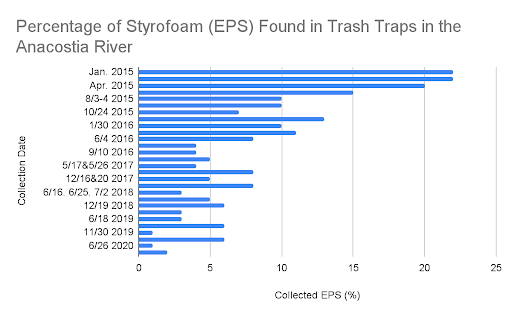Clay Napurano
Intern
Washington, D.C., is one of several cities and states that have banned some packaging made of polystyrene (otherwise known as Styrofoam) in recent years. The ban has led to less foam trash turning up in local waterways.
Intern
Cities and states around the country have taken steps to ban certain single-use plastics – straws, plastic bags, polystyrene take-out containers and more. These policies are aimed at reducing the flow of plastic into our waterways and the waste stream. But do they work?
In this blog series, we present four examples of single-use plastics bans that are reducing plastic pollution.
Polystyrene, or as it is known commercially, Styrofoam, is a petroleum-based plastic product that is incredibly lightweight and commonly used to insulate food and beverages. It is greatly harmful to the environment, contributing to marine debris and often polluting waterways and landfills.
The Anacostia River in Washington, D.C. flows through Maryland and empties into the Potomac River. In December 2011, before D.C. placed an effective ban on polystyrene food container products, foam and other expanded polystyrene products made up 37% of all waste collected from the river by the Anacostia Watershed Society.
Washington, D.C., instituted a polystyrene ban as part of the Sustainable D.C. Omnibus Act of 2014. This act included a ban on expanded and extruded polystyrene that took effect in 2016, requirements for recyclable and compostable foodware by 2017 and a ban on single-use plastic straws to take effect on January 1, 2019. D.C. is one of a number of jurisdictions across the country that have implemented bans on polystyrene products in recent years, including Maine, Maryland and Vermont.

Data From Trash Traps Collected and Recorded by the Anacostia Watershed Society [1]
In the first year after the ban, the portion of polystyrene caught in trash traps in the Anacostia River decreased by more than half (see figure above). (There was also a significant reduction around 2015 before the ban took place; this could have been due to a number of things, including consumer pressure, companies anticipating the ban or companies changing their practices on their own.) In 2016, polystyrene only made up 7% of the collected waste, falling from 15% in 2015. This percentage fell by half again to 3% in 2020. Businesses also quickly became compliant with the ban, with the compliance rate increasing from 60% in 2015 to 96% in 2020.
The ban was amended in 2021 to include the retail sale of foamware such as coolers, ice chests and packing peanuts, measures that should further reduce the flow of foam into D.C. ‘s rivers.
[1] Masaya Maeda, Anacostia Watershed Society, Watch the Foam Go Down, 27 December 2020, accessed at https://www.anacostiaws.org/blog/watch-the-foam-go-down.html.
Photo credit Waferboard via Flickr (CC-BY-2.0)
Intern
